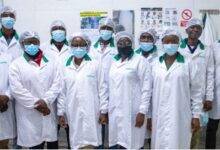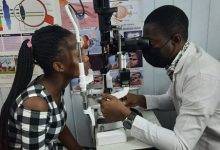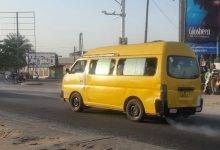But for the timely intervention of a retired Catholic Priest on his usual charity visits, she would have been whisked away to be sacrificed for rituals as custom demands for the punishment of an ‘evil child’.
Abandoned by her mother at the hospital and a father who rarely visits after being diagnosed of leprosy, two-year old Priscilla had two options; either face death or forever suffer neglect.
Almost a year after her rescue and relocation to the Weija Leprosarium in Accra, the only relative in contact with Priscilla is her grandmother and that is because she took the risk to transport her from Wa in the Upper West Region of Ghana, to the facility.
Unfortunately, a ghastly accident enroute Accra while conveying Priscilla to the Leprosarium has since left the grandmother with a fractured leg and stuck at the facility, but that means little to the now three-year-old child.
One would have thought that the presence of her relative would inspire a close bond as it is natural of children and their caregivers, but Priscilla would go to any other person including strangers that visit the Leprosarium – not her grandmother.
Clearly, the trauma, pain and dereliction Priscilla must have suffered back home still haunts her – nine months after relocating to the Leprosarium, despite the love, care and attention managers and inmates show her just as every other human being deserves in life.
Stigma, discrimination, maltreatment, dejection and rejection constitute a common experience among persons diagnosed of leprosy, otherwise known as Hansen’s disease; a chronic yet curable infectious disease that mainly causes skin lesions and nerve damage.
The disease, caused by an organism called mycobacteriamleprae, mostly affects the skin, eyes, nose and peripheral nerves of the human body and transmitted by coming into prolonged contact with an infected person through droplets from the nose and mouth.
While mode of spread may seem quick, one’s immunity according to health experts, has a high bearing on whether or not the disease would finally manifest in an individual after its incubation period which may take from two to 20 years.
STATISTICS:
Leprosy is one of the 14 neglected tropical diseases (NTDs) Ghana is grappling with and a public health problem globally.
The disease is said to affect about 200,000 people worldwide each year with millions of people living with the damaging effect of delayed leprosy treatment.
In Ghana, over the last five years, at least 200 new cases of leprosy have been recorded each year.
Even more worrying is the trend of new cases among children which health authorities believe was indicative of ongoing transmission of the bacteria among the population.
Latest data from the National Leprosy Control Programme (NLCP) of the Ghana Health Service (GHS) indicates that as of September last year, 221 new cases of leprosy had been reported; seven involving children.
All 16 regions of Ghana were endemic for leprosy although the Upper East and Upper West regions report the highest number of new cases annually.
“This tells us that transmission is ongoing and we are all at risk. The only luck is that a lot of us have strong immunity and our body naturally fights the organism, else we would have had a huge problem on our hands,” the Programmes Manager, Dr Benedict OkoeQuao, said in an interview.
TREATMENT
According to Dr Quao, the risk of spread of leprosy among the population had resulted in the revision of the Programmes control strategy.
Thus, for every diagnosed case, aside the administration of the multi-drug therapy (MDT) which takes at least six months and at most a year to cure the disease, the Service was now aggressively pursuing all contacts around a case to give prophylaxis and break the risk of transmission.
“Every leprosy case will occur around an old one when you trace the source; so now, we are not only focused on treating the cases we get, but to find their contacts; people you have spent averagely 20 hours with in a week, and protect them from the infection by giving them single dose rifampicin,” he stated.
Zero Leprosy:
The World Health Organisation (WHO) wants countries all over the world to declare “Zero Leprosy” by 2030 and in line with the new NTD roadmap 2021-2030, the international health organisation targets that in the next seven years, there will be zero-leprosy infection, zero-disability and zero-stigma and discrimination associated with persons diagnosed of leprosy.
A 2010 Global Burden of Disease study established that NTDs accounted for 26.6 million disability-adjusted life years (DALYs) worldwide and is of immense socio-economic burden on national development.
Ghana’s new master plan to deal with NTDs, launched in 2021, hopes to eradicate all NTDs that are still endemic in the country, including leprosy before the WHO target date of 2030.
In line with the “Zero Leprosy” agenda, the NLCP has the goal to reduce new leprosy infections by 70 percent, reduce grade two disability from leprosy by 90 percent, achieve 90 percent reduction in child leprosy cases and totally eradicate stigma and discrimination by 2030.
THE STIGMA PROBLEM:
While all other goals may be attainable, stigma and discrimination against persons diagnosed or suffering the effect of leprosy could be the greatest hurdle to overcome.
A lot of cruelty meted out to patients, Dr Quao admitted, were based on myths, misconceptions and low public knowledge on the disease.
“For instance, hugging someone cured of leprosy won’t make you get it. Most of the people with disability, especially the clawed fingers or toes are cured. They don’t have the disease but the claws is a disability and may remain.
However, the real threat may be the gentleman in suit or lady beside you who may have a patch under their clothes, coughing and talking all over the place and that is where you can pick the infection. Fact is that, after the incubation period, the disease would begin to manifest; but we rather stigmatise the cured person with deformity.”
PHEF:
For Dr Quao, interventions for diseases like leprosy which has public health implications, ought to be more extensive to achieve maximum impact.
He, thus, justified the need for the establishment for the Public Health Emergency Fund (PHEF) which could help provide sustainable investment and funding into leprosy interventions such as procuring more prophylaxis drugs (which is about 60 percent effective against leprosy).
“Currently, we have funding to administer rifampicin in only six regions and that is from foreign donor organisations. If you suspect a case now, you need to send in logistics to do tracing among other investigations but at whose cost?
If we had a dedicated fund where the state or Ghanaians could contribute to regularly, we could tap into it to implement preventive measures against such public health threats as a country so that we are not overwhelmed by it as COVID-19 did to us.
Leprosy is slow. It may not kill a lot of people like COVID-19,but over the period of incubation, it may affect a lot of people and has huge socio-economic implication. If we are to achieve our 2030 target, we need to break the chain of transmission,” Dr Quao added.
Future for Priscilla and others:
The Reverend Father Andrew Campbell, Head of the Weija Leprosarium and a retired Parish Priest of the Christ the King Parish, who rescued Priscilla from the ‘claws of death’ decried the extent of cruelty meted out to leprosy patients adding, “it cuts across all facets of the society-family, the workplace, health workers and society at large.”
“The stigma won’t go away and that is the awful thing preventing the elimination of leprosy,” he shared in an interview.
Having dedicated his life in the last three decades to championing a life of respect and dignity for ‘lepers’ in the country, Father Campbell called for increased education and sensitisation on leprosy to change the current narrative.
“I may not live long enough to give Priscilla all the love and care she needs but I am committed to doing all within my power to ensure the best for her and others living here,” he said.
Priscilla has had her right foot amputated due to delayed treatment of leprosy and may for the rest of her life be physically challenged but she looks to the future with high hopes and seems determined to realise her full potential, provided society embraces her and gives her the needed environment to thrive.
The effect of leprosy may be permanent but the disease is not.
BY ABIGAIL ANNOH




